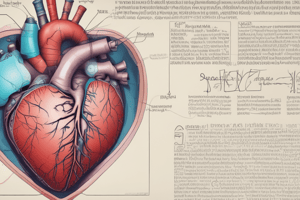Podcast
Questions and Answers
What is the definition of Flexion?
What is the definition of Flexion?
- Bending joints or decreasing the angle between two bones. (correct)
- Moving a body part away from the midline.
- Straitening a joint or increasing the angle.
- Excessive extension of the part past anatomical position.
What does Extension refer to?
What does Extension refer to?
- Straitening a joint or increasing the angle. (correct)
- Bending joints or decreasing the angle between two bones.
- Turning the arm or foot downward.
- Moving a body part towards the midline.
What is Hyperextension?
What is Hyperextension?
- Moving a body towards the midline.
- Raising a part.
- Lowering a body part.
- Excessive extension of the part past anatomical position. (correct)
What does Adduction mean?
What does Adduction mean?
What is the definition of Abduction?
What is the definition of Abduction?
Define Pronation.
Define Pronation.
What is Supination?
What is Supination?
What does Retraction mean?
What does Retraction mean?
Define Protraction.
Define Protraction.
What does Elevation refer to?
What does Elevation refer to?
What is the definition of Depression?
What is the definition of Depression?
Define Rotation.
Define Rotation.
What does Circumduction mean?
What does Circumduction mean?
What is External Rotation?
What is External Rotation?
Define Internal Rotation.
Define Internal Rotation.
What does Lateral Flexion refer to?
What does Lateral Flexion refer to?
What is Inversion?
What is Inversion?
Define Eversion.
Define Eversion.
What does Dorsiflexion mean?
What does Dorsiflexion mean?
What is Plantarflexion?
What is Plantarflexion?
Define Radial Deviation.
Define Radial Deviation.
What does Ulnar Deviation mean?
What does Ulnar Deviation mean?
What is Opposition?
What is Opposition?
Flashcards are hidden until you start studying
Study Notes
Flexion and Extension
- Flexion: Decreases the angle between two bones by bending joints.
- Extension: Straightens a joint, increasing the angle between two body parts.
Hyperextension and Movement Toward Midline
- Hyperextension: Involves extending a body part beyond its normal anatomical position.
- Adduction: Moves a limb or body part toward the midline of the body.
Abduction and Rotational Movements
- Abduction: Involves moving a body part away from the midline.
- Pronation: Refers to the act of turning the arm or foot downward.
- Supination: Involves turning the foot or palm upward.
Retraction and Protraction
- Retraction: Moves a part, such as the shoulder or jaw, backward.
- Protraction: Moves a body part forward.
Elevation and Depression
- Elevation: Raises a part of the body, such as the shoulder or jaw.
- Depression: Lowers a body part.
Rotation and Circumduction
- Rotation: Involves turning a body part around a single axis.
- Circumduction: A circular motion, typically seen at the hip or shoulder joints.
Internal and External Rotation
- External Rotation: Rotates the hip or shoulder away from the body's midline.
- Internal Rotation: Rotates the hip or shoulder toward the midline.
Lateral Flexion and Inversion/Eversion
- Lateral Flexion: Side-bending the torso either left or right.
- Inversion: Turns the sole of the foot inward.
- Eversion: Turns the sole of the foot outward.
Dorsiflexion and Plantarflexion
- Dorsiflexion: Involves bringing the foot toward the shin through ankle movement.
- Plantarflexion: Points the foot downward from the ankle.
Deviations and Opposition
- Radial Deviation: Movement of the wrist towards the radius bone.
- Ulnar Deviation: Movement of the wrist towards the ulna bone.
- Opposition: Movement of the thumb across the palm, allowing for grasping and pinching.
Studying That Suits You
Use AI to generate personalized quizzes and flashcards to suit your learning preferences.




